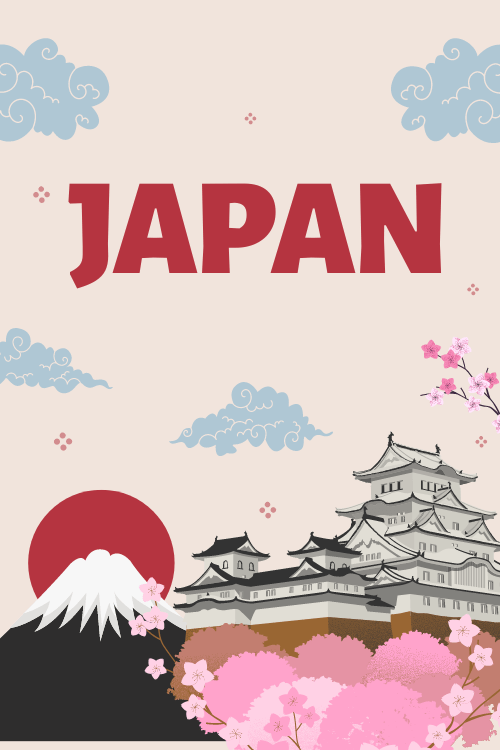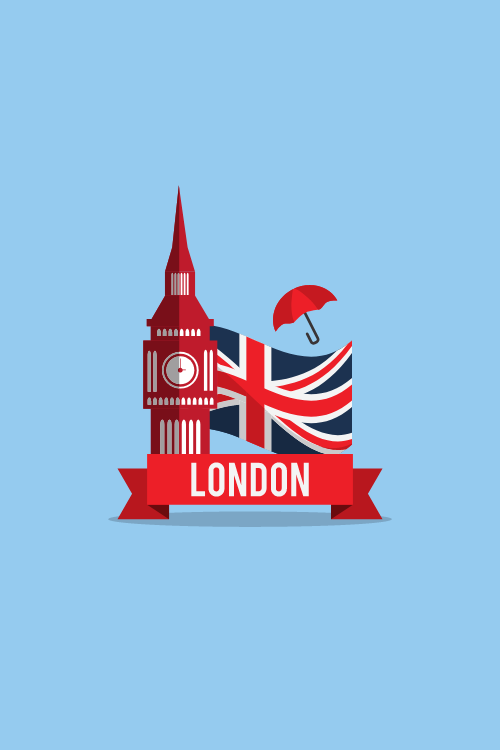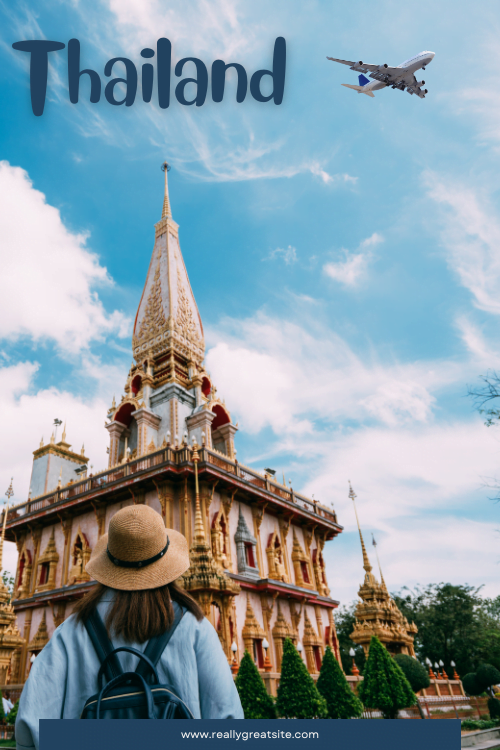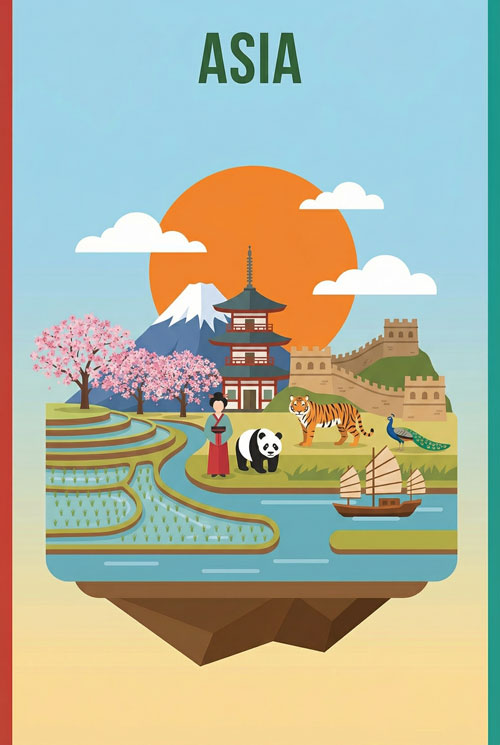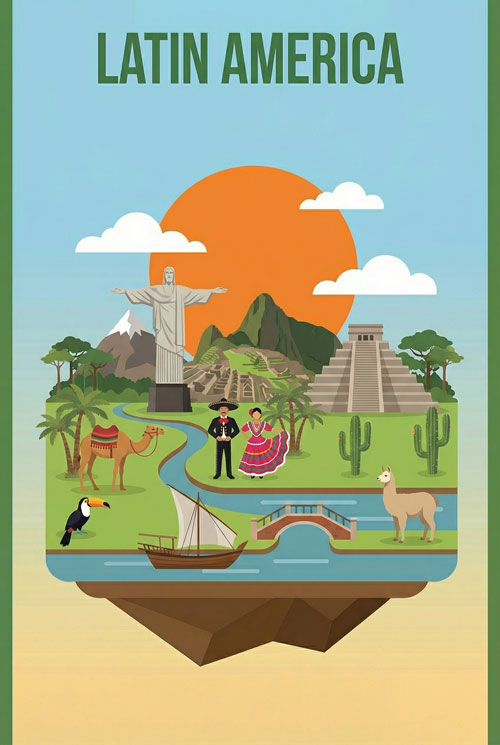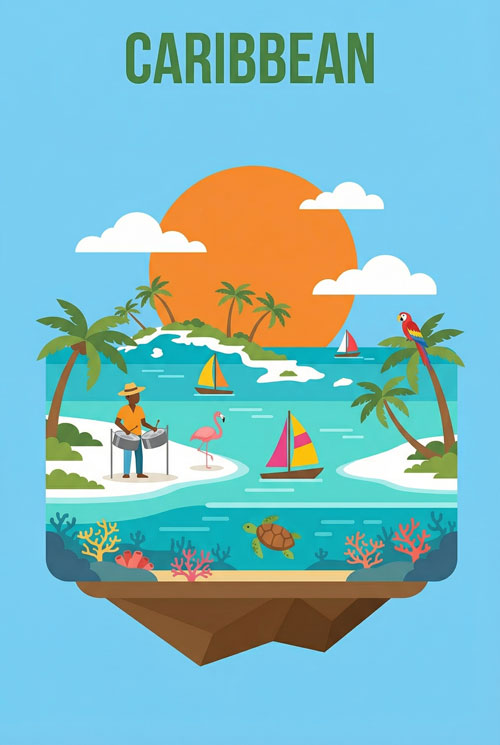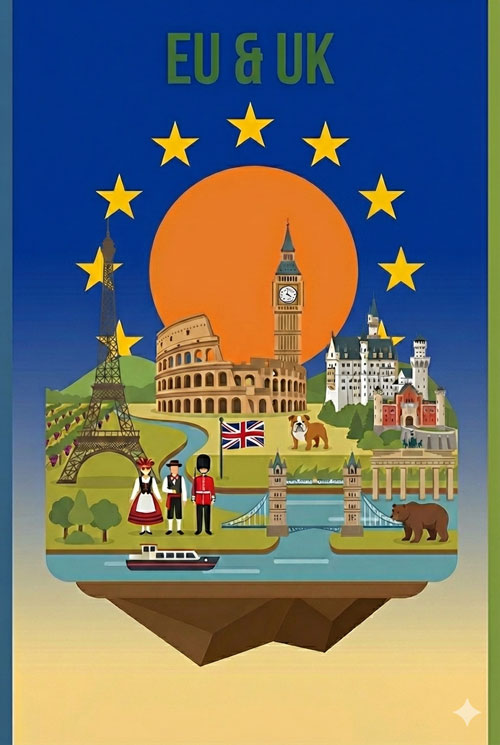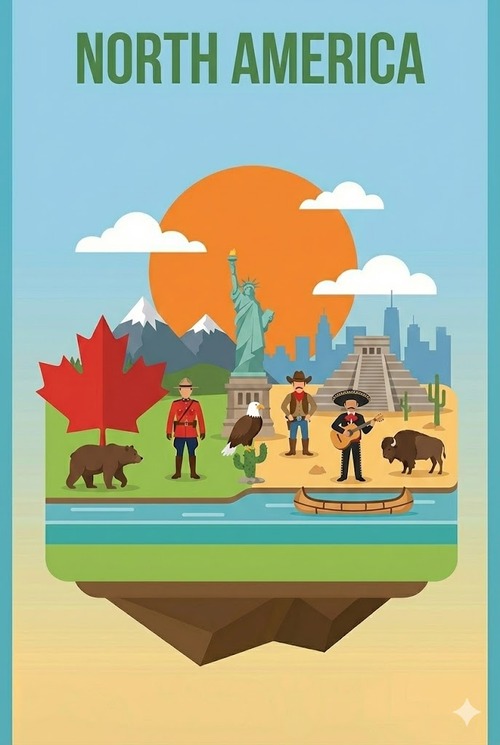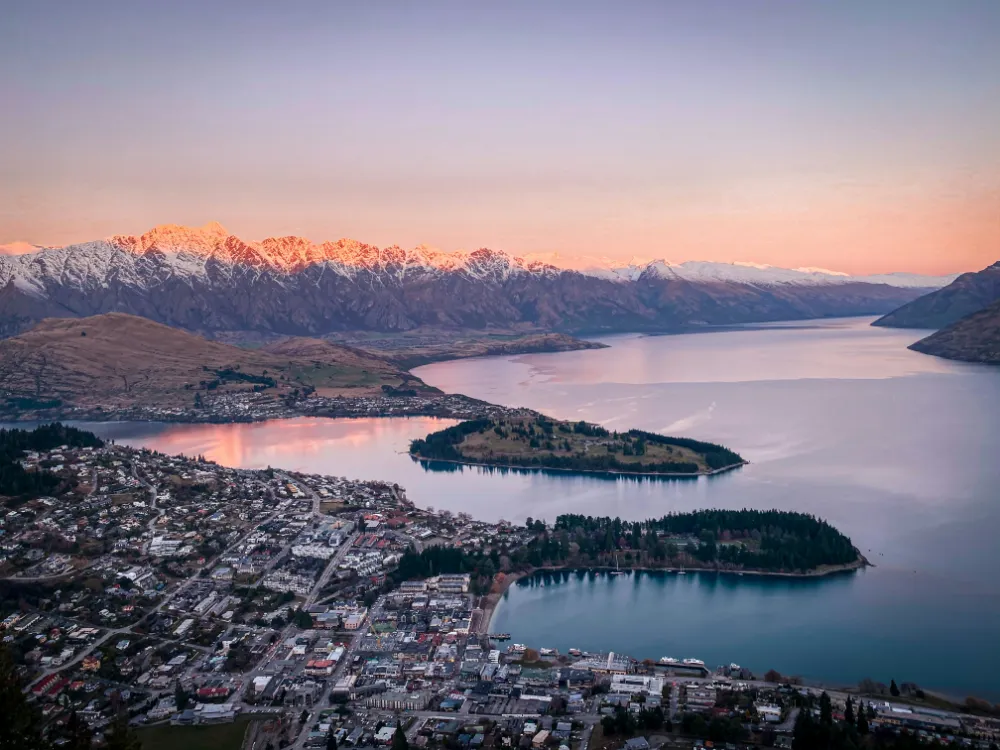eSIM New Zealand
The Best Time to Visit Queenstown, New Zealand
Nestled by the shores of the shimmering Lake Wakatipu and cradled by the majestic Southern Alps, Queenstown is New Zealand’s undisputed adventure capital. It’s a destination that transforms dramatically with the seasons, offering a completely different but equally magical experience whether you visit under the summer sun or a blanket of winter snow.
So, when is the best time to visit Queenstown? The truth is, there’s no single right answer. The perfect time for your trip depends entirely on what you’re looking for. Are you dreaming of long, sun-drenched days spent hiking epic trails? Or are you chasing fresh powder on world-class ski slopes?
Do you want to save money and avoid the crowds, or are you looking to dive into the buzz of a major festival?
This guide is here to help you decide. We’ll break down everything you need to know about Queenstown’s distinct seasons, from weather and crowds to prices and activities.
We’ll give you the inside scoop so you can choose the absolute perfect time for your unforgettable New Zealand adventure.
Queenstown At-a-Glance: The Quick Guide for Travelers in a Hurry
For those who want the highlights right away, here’s the cheat sheet for planning your Queenstown trip.
- Best Time for Sunshine & Great Weather: Summer (December – February). The days are long, warm, and sunny, creating perfect conditions for hiking, lake activities, and soaking up the vibrant atmosphere.
- Best Time for Skiing & Snowboarding: Winter, specifically mid-July through August. This is the heart of the ski season, offering the most reliable snow cover and the best powder conditions on the slopes.
- Best Time for Budget Travelers: The shoulder seasons. May, June, and October through November typically offer the lowest prices on flights and accommodation, letting you experience the beauty of Queenstown for less.
- Best Time to Avoid Crowds: The shoulder months of May and November. These periods fall neatly between the major holiday rushes, offering a more peaceful and relaxed experience.
- Best Time for Stunning Autumn Colors: Late April to early May. This is the prime window to witness the breathtaking transformation of the landscape, especially in nearby Arrowtown, as the hillsides erupt in fiery shades of gold, orange, and red.
- Best Time for Hiking: Autumn (March – May) and Spring (September – November). You’ll find comfortable temperatures for hitting the trails, fewer people, and spectacular scenery, from golden foliage to spring wildflowers.
Queenstown by the Numbers: A Monthly Snapshot
To help you visualize the year, this table breaks down what you can expect each month. Crowd and cost levels are based on flight and accommodation prices and tourist traffic, with ‘$’ and ‘Low’ representing the most affordable and quietest periods.
| Month | Avg. Temp (°C / °F) | Crowd Level | Cost Level | What’s On & Best For |
| January | 15°C / 59°F | High | $$$ | Peak summer adventures: hiking, biking, lake activities. Lake Hayes A&P Show, Queenstown Bike Festival. |
| February | 15°C / 59°F | High | $$$ | Continued summer buzz. Best month for hiking. Gibbston Valley Summer Concert. |
| March | 13°C / 55°F | Medium | $$ | Milder weather, fewer crowds. Start of autumn colours. Great for hiking and wine tours. NZ Open, Motatapu. |
| April | 10°C / 50°F | Medium | $$ | Peak autumn colours begin. Arrowtown Autumn Festival is a must-see. Excellent for photography and hiking. |
| May | 7°C / 44°F | Low | $ | Quietest month, best deals on hotels. Cool, crisp days. Wettest month of the year. |
| June | 4°C / 39°F | Medium | $$ | Ski season begins! Winter festivals like LUMA and Mardi Gras kick off. Good deals on accommodation. |
| July | 3°C / 37°F | High | $$$ | Peak ski season. Coldest month. School holidays mean big crowds and high prices. |
| August | 5°C / 41°F | High | $$$ | Excellent snow conditions continue. Winter Pride Festival. A powder-hound’s dream. |
| September | 7°C / 44°F | Medium | $$ | Spring skiing with sunny days and softer snow. Flowers begin to bloom. Snow Machine music festival. |
| October | 8°C / 46°F | Low | $ | A quiet shoulder month with unpredictable weather. Ski season ends, but summer activities aren’t in full swing yet. |
| November | 11°C / 51°F | Low | $ | The adventurer’s secret month. Great weather, fewer crowds, and the driest month. Queenstown Marathon. |
| December | 14°C / 57°F | High | $$$ | Summer season kicks off. Long, warm days return. Holiday buzz builds towards New Year’s Eve fireworks. |
A Detailed Guide to Queenstown’s Four Distinct Seasons
Every season in Queenstown paints the landscape in a new light. Here’s a deep dive into what each one feels like, helping you find the perfect match for your travel style.
Summer in Queenstown (December – February): The Peak of Adventure
Summer is when Queenstown truly comes alive. The energy is infectious, the days are gloriously long, and the landscape is primed for adventure.
Weather Deep Dive
Expect long, luminous days with the sun rising as early as 5 am and setting as late as 10 pm. This gives you maximum daylight for exploring. Average daytime temperatures hover between a very pleasant 20°C to 25°C (68°F to 77°F), though it’s not uncommon for the mercury to push towards 30°C (86°F) on a hot day. The New Zealand sun is famously strong due to less ozone and air pollution, so being “SunSmart” with a hat, sunglasses, and high-SPF sunscreen is essential, even on cloudy days. While December and February are relatively dry, January can surprisingly be one of the wetter summer months, so a light rain jacket is still a wise addition to your suitcase.
Pros
This is, without a doubt, the best time for the full spectrum of Queenstown’s legendary outdoor activities. The weather is perfect for tackling high-altitude hiking trails like the iconic Ben Lomond summit, which are often inaccessible at other times of the year. The lake beckons for swimming, kayaking, and jet boating, while the region’s 130 km of cycle trails are in prime condition. The town itself buzzes with a vibrant, festive atmosphere, with cafes and restaurants spilling out onto the sidewalks.
Cons
The secret is out—summer is a phenomenal time to be in Queenstown, and you’ll be sharing it with many others. This is the absolute peak tourist season, driven by fantastic weather and the major Christmas, New Year, and summer school holidays for both New Zealand and Australia. This means you should expect the largest crowds of the year and the highest prices for flights, accommodation, and rental cars. January and December are the most expensive months for flights from the US, while February is typically the priciest for hotels. Spontaneity is difficult; booking accommodation and popular activities months in advance is not just a recommendation, it’s a necessity to avoid disappointment.
Autumn in Queenstown (March – May): A Photographer’s Golden Dream
As the summer crowds depart, Queenstown undergoes a breathtaking transformation. The pace slows, the air turns crisp, and the landscape erupts in a world-renowned display of colour. Autumn is a season of two halves, each offering a distinct experience.
Early Autumn (March – Mid-April): The Summer Hangover
The first half of autumn feels like a quieter, more affordable extension of summer. The weather remains pleasantly mild, with daytime temperatures often reaching 20°C (68°F), perfect for hiking and biking without the intense heat of February. The trails are less crowded, and you’ll start to find better deals on accommodation as the peak season demand wanes. This period is also the heart of the grape harvest in the nearby Gibbston wine region, making it a particularly special time for a wine tour.
Late Autumn & Peak Colour (Late April – May): The Golden Season
This is what autumn in Queenstown is famous for. From the last week of April into early May, the hillsides around Queenstown and, most spectacularly, the historic village of Arrowtown, are set ablaze with brilliant reds, oranges, and golds. It’s a photographer’s absolute dream. The weather cools down significantly, with average highs in May dropping to around 12°C (53°F) and chilly nights that demand warm layers. Be prepared for rain, as May is one of the wettest months of the year, but the reward is witnessing one of nature’s most stunning displays.
Pros
The main draw is the scenery—it’s simply world-class. The Arrowtown Autumn Festival in April is a major highlight, celebrating the season with markets, parades, and community events. This season offers a fantastic balance of incredible landscapes, thinner crowds, and excellent value for money.
Cons
The weather becomes much more unpredictable as the season wears on, and by May, you’ll need to pack for winter-like conditions. The days get noticeably shorter, reducing your time for outdoor exploration.
Winter in Queenstown (June – August): A Snowy Paradise
When winter arrives, Queenstown sheds its green and gold for a pristine coat of white. The mountains become a playground for skiers and snowboarders, and the town itself takes on the cozy, magical atmosphere of a winter wonderland.
Weather Deep Dive
Prepare for the cold. Daily temperatures typically range between -4°C and 8°C (24°F to 46°F). While heavy snow is common on the surrounding mountains like The Remarkables and Coronet Peak, it’s less frequent in the town centre itself, though heavy frosts are a regular morning occurrence. The days are short, with daylight lasting less than nine hours in June, but they are often crisp and clear with brilliant blue skies. Humidity is at its highest point of the year, which can make the cold feel more intense.
Pros
This is the ultimate season for snow sports enthusiasts. Queenstown is the hub for four world-class ski fields—Coronet Peak, The Remarkables, Cardrona, and Treble Cone—all of which are in full operation. The town’s vibrant après-ski scene comes to life, with roaring fires and mulled wine in cozy bars. A packed calendar of events, including the dazzling LUMA light festival (June), the Queenstown Winter Festival (June), and the vibrant Winter Pride (August), adds to the festive atmosphere.
Cons
Winter is Queenstown’s second peak season. The New Zealand and Australian school holidays in July bring a massive influx of visitors, making it one of the busiest and most expensive times of the year. You’ll need to pack seriously warm, waterproof clothing. Many of the famous high-altitude hiking trails, like Ben Lomond, are closed or unsafe due to snow and avalanche risk.
Decoding the Ski Season
Not all of the ski season is created equal. The experience can change dramatically from the first snowfall to the last spring slush.
- Early Season (Mid-June to Early July): This is the best time for budget-conscious skiers and first-timers. You’ll find great deals on lift passes and accommodation. The snow conditions can be variable as the base is still building, but the slopes are much quieter.
- Peak Season (Mid-July to Late August): This is prime time for powder hounds. The snow base is deep, and regular storms deliver fresh powder. This period, especially during the July school holidays, sees the biggest crowds and the highest prices.
- Spring Skiing (September to Early October): The vibe becomes more relaxed. Think sunny “t-shirt” skiing days, soft, forgiving snow, and a lively après-ski scene. It’s an ideal time for families, learners, and groups looking for a fun, social ski trip with fewer queues.
Spring in Queenstown (September – November): The Season of Everything
Spring is Queenstown’s season of renewal and variety. It’s a time of dramatic contrasts, where snow-capped peaks tower over valleys bursting with green grass and colourful blossoms. It’s the one time of year you can genuinely do it all.
Weather Deep Dive
This is the most unpredictable season—you truly can experience four seasons in one day. September often feels like a continuation of winter, and the ski season frequently runs until the end of the month. Temperatures can swing wildly, from a chilly 8°C to a pleasant 22°C (46°F to 71°F). While November is often the driest month of the year, making it fantastic for outdoor pursuits, October can be quite wet. Layering your clothing is key.
Pros
Spring is the “do-it-all” season. It’s famous for “spring-skiing,” where you can hit the slopes in the morning and then spend the afternoon mountain biking, hiking, or even playing a round of golf in the valley. The landscape comes alive with colour, from cherry blossoms lining the streets to fields of bright yellow kowhai and newborn lambs frolicking in the pastures. As a shoulder season, it offers a sweet spot of smaller crowds and lower prices compared to the summer and winter peaks. November, in particular, is an adventurer’s secret, offering summer-like weather without the summer crowds.
Cons
The biggest downside is the weather’s unpredictability. You must be prepared for anything, from a warm, sunny afternoon to a sudden cold snap with rain or even snow. Some attractions may still be operating on reduced winter hours or preparing to open for the summer.
The Best Time to Visit Queenstown, Based on Your Travel Style
To make it even simpler, here are our top recommendations tailored to your specific travel priorities.
The Cheapest Time to Go to Queenstown
If you’re traveling on a budget, the shoulder seasons are your best friend. The most affordable months to visit Queenstown are typically May, June, October, and November. During these times, demand for flights and accommodation drops significantly as they fall outside the major peak periods of summer (December-February) and the main ski season rush (July-August).
To maximize savings, book your flights at least a month in advance for domestic travel and two to four months for international flights. Traveling mid-week can also yield lower prices than on weekends. For accommodation, consider budget-friendly options like the excellent hostels in town or the well-equipped holiday parks and campgrounds, which offer incredible value, especially if you’re in a campervan.
The Best Time for Families
Queenstown is a fantastic year-round destination for families, with each season offering unique adventures.
- Summer (December – February): This is the ultimate choice for active families who love the outdoors. The warm weather is perfect for swimming in the lake, picnicking in the beautiful Queenstown Gardens, and enjoying the huge range of activities like the Skyline Luge, jet boating, and easy family hikes. The only drawback is that it’s the busiest and most expensive time.
- Winter (June – August): For a magical winter wonderland experience, this is the time to go. The ski fields offer excellent lesson programs for kids, making it a great place for families to learn to ski or snowboard together. Beyond the slopes, there are fun indoor activities like the ice arena and i-Fly for days when the weather is less inviting.
- Spring (September – November): This season offers a wonderful balance. The weather is pleasant for outdoor fun without the intense summer crowds. It’s a great time to visit a farm to see newborn animals or explore the blooming gardens. You can often still ski in September while enjoying spring activities in the afternoon.
The Best Time for Skiers & Snowboarders
For those chasing snow, the timing of your trip within the winter season can make all the difference.
- For the Best Powder: If you’re a serious skier or snowboarder hunting for deep powder days, aim for mid-July through late August. This is when the snow base is at its deepest and storms regularly refresh the slopes. Be aware this coincides with the busiest and most expensive period.
- For Beginners & Best Deals: The start of the season in mid-to-late June and the spring skiing period in September are ideal. The slopes are quieter, the snow is often softer and more forgiving, and you’ll find great deals on lift passes and accommodation.
- To Avoid the Crowds: The best way to get more laps in is to travel mid-week and avoid the New Zealand and Australian school holidays, which fall in early-to-mid July.
The Best Time for Hiking & Outdoor Adventure
While Queenstown offers adventure year-round, certain seasons are better suited for hitting the trails.
- For Most Hiking: Autumn (March-May) and Spring (September-November) are the sweet spots. These seasons provide the best combination of comfortable temperatures for hiking, more stable weather, and significantly fewer people on the trails. The scenery is also at its most dramatic, from the golden leaves of autumn to the lush greenery and wildflowers of spring.
- For High-Altitude Trails: If you have your heart set on conquering epic peaks like Ben Lomond, you must plan your trip for summer (December-February). These high-altitude tracks are often impassable due to snow and avalanche risk outside of the main summer months.
- For Winter Walks: Hiking is still possible in winter, but you’ll need to stick to lower-altitude trails. Walks like the Queenstown Gardens loop, Bob’s Cove Track, and the Lake Hayes Walkway remain accessible and offer stunning views of the snow-capped mountains. Always check track conditions with the Department of Conservation (DOC) and ensure you have appropriate warm clothing and footwear.
Stay Connected in Queenstown with an eSIM
Imagine you’ve just finished a stunning hike on the Tobin’s Track and want to find the best spot in Arrowtown for a well-deserved craft beer, or you’re driving the scenic route to Glenorchy and need to check for road closures. That’s when you’ll be glad to have instant, reliable data at your fingertips.
For international travelers, staying connected can be a major headache. Relying on your home provider’s international roaming can lead to shocking bills, with daily passes often costing between $8 and $15 USD. The alternative, buying a physical local SIM card, means wasting precious vacation time hunting down a store at the airport, dealing with potential queues, and physically swapping out your tiny SIM card.
This is where a modern travel solution comes in. An eSIM (or embedded SIM) is a digital SIM card that you can download to your phone, allowing you to connect to a local network without needing a physical card.
With an eSIM from eSIM.com, you can solve this before you even pack your bags. Simply purchase a data plan for New Zealand on our website, scan a QR code to install it, and you’ll be ready to connect the moment your plane touches down in Queenstown. No more bill shock, no more airport SIM queues, just seamless connectivity from the get-go. This allows you to use maps, book Ubers, and look up restaurant reviews from the second you arrive.
Check out eSIM.com for affordable, reliable data plans for your trip to Queenstown.

